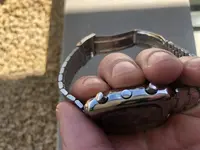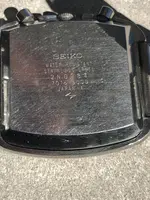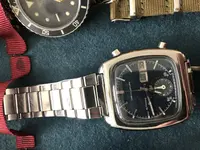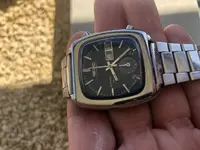A
alvarojmartin
Forer@ Senior
Sin verificar
Seiko Mónaco Blue 7016-5000 Flyback Chronograph y os adjunto, en ingles, lo que he encontrado por al red de gran interés sobre los Seiko Mónaco, profundamente interesante ...




y aquí la historia de los Mónacos, que he encontrado en la red y que me parece muy interesante ..., aunque sea en ingles ...
"The world of vintage Seiko chronographs is wholly dominated by the 6139 and 6138 calibers. And with good reason. These were the first two automatic chronographs movements introduced by Seiko. Indeed, the 6139 has a FAR better claim to the title of first automatic chronograph movement actually brought to market than does the presumptuously-names El Primero. The domination is also a consequence of the fact that these two movements power some of the most desirable, and indisputably popular of vintage Seiko chronographs. Pogues, Bullheads, Pandas and UFOs collectively rely upon this pair of movements for motive power.
But there is a far less-heralded member of the Seiko chronograph movement lineup that is arguably even more worthy of consideration by the discerning collector: the Seiko 7016A. Introduced in 1972 just a few short years after the 6139 and 6138 hit the market, this column wheel chronograph with vertical clutch offers combination of two features that no other movement of the time could match: a flyback function, for instantaneous reset / resume at the touch of a button and a single stacked register for displaying elapsed hour and minutes. Essentially, the elapsed time is displayed in its own self-contained and dedicated clock! This feature would not appear in
other production chronographs until the early 2000s (Patek) and later still in the impressive (if gargantuan) Omega cal. 9300.
It really is an ingenious solution to the elapsed time display question that instantly unclutters any chronograph dial. But the impressive credentials of the 7016A don't end there. At the time of its introduction it was the world's thinnest automatic chronograph movement at a scant 6.4mm. It would hold that title well into the '80s when the even more slender Piguet 1185 caliber was introduced.
A watch is more than just a movement, however. Much more. And in this instance the impressive 7016A is encased in the striking "Monaco" case so nick-named for its perceived similarity to the famous Heuer watch of that name. I feel there is at least an argumentto be made that it more resembles a blend of Heuer and Silverstone aesthetics, but that is very much beside the point.
The full model number is 7016-5000. This Seiko case design speaks of elegant solidity. It is presents solid rectangular, shape, softly rounded and brushed to a satin sheen. The crown is recessed almost fully flush with the case, adding to its streamlined appearance.
The dimensions are compact and wearable at 37mm wide and 41mm lug to lug. That latter dimension is somewhat misleading given that this watch features the shortest lugs I have ever personally encountered on a watch. Strap changes (19mm lug width) are quite a challenge! Suffice it to say that the lug-to-lug measure is almost all watch. The dial is a model of simplicity and legibility.
Absent a constant second hand, the chrono sweep hand and single stacked register are all that is required beyond the primary timekeeping functions. This particular example shows some oxidation of the hour and minute hands along with a degree of mottled patina on the stacked register subdial. But the striking beauty of the deep blue green dial is undiminished.
Using and wearing this chronograph can be summed up in two words: pure delight. The action of the chronograph pushers is positive, precise and consistent. The hands resent crisply and, if the flyback function is engaged, resume elapsed timing in an instantaneous blink. Having been fully serviced prior to purchase, the timekeeping has been rock solid. And as mentioned, the compact dimensions and understated styling make this watch entirely wearable in circumstance where a Bullhead would be a bit too.... much"




y aquí la historia de los Mónacos, que he encontrado en la red y que me parece muy interesante ..., aunque sea en ingles ...
"The world of vintage Seiko chronographs is wholly dominated by the 6139 and 6138 calibers. And with good reason. These were the first two automatic chronographs movements introduced by Seiko. Indeed, the 6139 has a FAR better claim to the title of first automatic chronograph movement actually brought to market than does the presumptuously-names El Primero. The domination is also a consequence of the fact that these two movements power some of the most desirable, and indisputably popular of vintage Seiko chronographs. Pogues, Bullheads, Pandas and UFOs collectively rely upon this pair of movements for motive power.
But there is a far less-heralded member of the Seiko chronograph movement lineup that is arguably even more worthy of consideration by the discerning collector: the Seiko 7016A. Introduced in 1972 just a few short years after the 6139 and 6138 hit the market, this column wheel chronograph with vertical clutch offers combination of two features that no other movement of the time could match: a flyback function, for instantaneous reset / resume at the touch of a button and a single stacked register for displaying elapsed hour and minutes. Essentially, the elapsed time is displayed in its own self-contained and dedicated clock! This feature would not appear in
other production chronographs until the early 2000s (Patek) and later still in the impressive (if gargantuan) Omega cal. 9300.
It really is an ingenious solution to the elapsed time display question that instantly unclutters any chronograph dial. But the impressive credentials of the 7016A don't end there. At the time of its introduction it was the world's thinnest automatic chronograph movement at a scant 6.4mm. It would hold that title well into the '80s when the even more slender Piguet 1185 caliber was introduced.
A watch is more than just a movement, however. Much more. And in this instance the impressive 7016A is encased in the striking "Monaco" case so nick-named for its perceived similarity to the famous Heuer watch of that name. I feel there is at least an argumentto be made that it more resembles a blend of Heuer and Silverstone aesthetics, but that is very much beside the point.
The full model number is 7016-5000. This Seiko case design speaks of elegant solidity. It is presents solid rectangular, shape, softly rounded and brushed to a satin sheen. The crown is recessed almost fully flush with the case, adding to its streamlined appearance.
The dimensions are compact and wearable at 37mm wide and 41mm lug to lug. That latter dimension is somewhat misleading given that this watch features the shortest lugs I have ever personally encountered on a watch. Strap changes (19mm lug width) are quite a challenge! Suffice it to say that the lug-to-lug measure is almost all watch. The dial is a model of simplicity and legibility.
Absent a constant second hand, the chrono sweep hand and single stacked register are all that is required beyond the primary timekeeping functions. This particular example shows some oxidation of the hour and minute hands along with a degree of mottled patina on the stacked register subdial. But the striking beauty of the deep blue green dial is undiminished.
Using and wearing this chronograph can be summed up in two words: pure delight. The action of the chronograph pushers is positive, precise and consistent. The hands resent crisply and, if the flyback function is engaged, resume elapsed timing in an instantaneous blink. Having been fully serviced prior to purchase, the timekeeping has been rock solid. And as mentioned, the compact dimensions and understated styling make this watch entirely wearable in circumstance where a Bullhead would be a bit too.... much"


